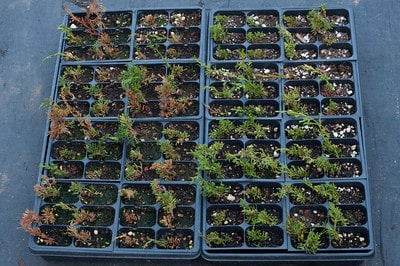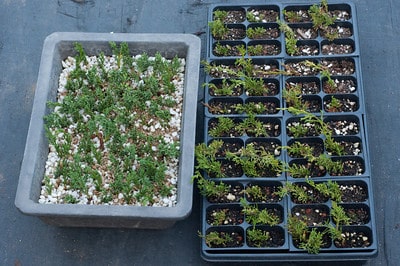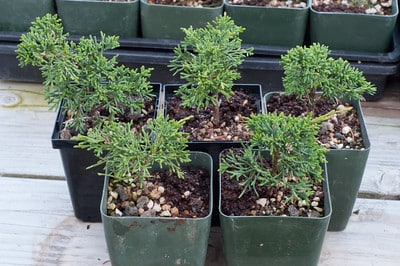A few months back I grabbed an armful of juniper branches from the green recycling bin at a Bay Island Bonsai workshop. I’d found both kishu and itoigawa shimapku branches and figured I could use them to make cuttings for grafting roots or branches. Although I’d made cuttings many times before, I wasn’t sure about what soil worked best to facilitate rooting or how long to leave new cuttings in the greenhouse before bringing them outside. An experiment was in order.
I tested three different soil mixes outside and in a greenhouse. Despite poor experimental design and uneven care after the cuttings were made, I was surprised to find fairly consistent results. I planted the cuttings in “houseplant soil” (an all-purpose soil mix rich in organic ingredients), perlite, and a mix of perlite and sand. The perlite yielded better results than the houseplant mix, and the sand and perlite mixture yielded better results than perlite alone. Overall, the cuttings I left outside fared better than those left in the greenhouse, but I suspect that’s mostly because the cuttings I left in the greenhouse were watered erratically. Here are some photos of the cuttings after a few months.

“Houseplant soil” (greenhouse) :: perlite (greenhouse)

“Houseplant soil” (greenhouse) :: “Houseplant soil” (outside)

Perlite and sand (greenhouse) :: “Houseplant soil” (outside)
The cuttings planted in perlite and sand fared equally well indoors and out. I wasn’t too surprised by this as Boon Manakitivipart and others recommended this mix and it offers a good balance of drainage and moisture retention. It’s also a sterile mix, unlike the “houseplant” mix I used. Why did I try the houseplant mix? Mostly out of curiosity. And why did I use cell packs instead of larger containers? Simply to save the time of wiring screens into more pots. I’ll repot all of the viable cuttings into bonsai soil this coming winter.

Last year’s cuttings
I shared this story less to encourage the use of perlite and sand than to encourage any amount of research on the topic. Many people are experts at this – are you one of them? If anyone knows of good resources about making cuttings, feel free to share. I used rooting hormone for all of the cuttings and made clean, slanted cuts with a grafting knife. I also planted all of the cuttings at an angle. Are there better approaches to preparing and planting the cuttings? I experimented with small, medium, and large sized cuttings and found that all lived, but there may be good reasons to start larger or smaller cuttings. Any suggestions?
Subscribe to Bonsai Tonight
New Posts Delivered Every Tuesday and Friday
Rusty says
Jonas, it is like we have ESP(n) :). This year I tried cuttings from maple and sweat gum (winged) and they did not do very well. I planted them in pure perlite and I think one of the reasons is that the cuttings were not very stable in the perlite. This maybe one of the reasons perlite is better with sand, because sand serves as a stabilizer. Also, I don’t think I planted deep enough and when watering the cuttings would move. I wonder if you tried adding a rooting hormone and whether you think it helps.
Thank you.
Rusty
Juan says
Jonas,
I start my Shimpaku cuttings in pure perlite, have for years. The difference may be that I use a thick layer of Sphagnum Moss on the surface, poke a hole through with a chopstick and then insert the cutting (at an angle) in to the hole after it has been dipped in rooting hormone. Water in well and set under a bench. I have done this in November, in March, In June, July, etc. 95% and greater take rate. We are now starting to wire them before placing in the perlite starter medium. John
Mary says
Jonas, I had a 5 acre wholesale bonsai nursery in South Florida for many years. Shimps were as easy as Ficus to root! After some experimenting, my favorite way to root them was directly in the smallest grade bonsai soil I could find. A little dab of sphagnum moss was an easy way to cover the holes in the small nursery pots. Rarely lost any.
When it came time to repot, it wasn’t necessary to get the old “soil” off. I never used rooting hormone nor Superthrive on them (which is another whole story.) Mary
Zack Clayton says
Jonas, I have had good success with what was sold as calcined clay – hard fired particles about .5 to 1 mm in size. It is very similar to turface fines. I root deciduous and juniper in this with no rooting compound but do heavily top mist. This gives good success with junipers up to 8 inch whips preparing for phoenix grafts. I am in Ohio and the cuttings are done in Spring and put in shade. I do use a cloning gel on harder to strike species and air layers.
I would like to know where Juan is taking cuttings year around, One of the things we teach beginners is to look at where an author is writing from. It can make a huge difference.
Juan says
Zack, we have done in Arkansas and Connecticut (with protection starting in October). Cheers.
Zack Clayton says
Ah, thank you. The protection starting in October will keep someone from a mistake north of zone 7.
We had a member who read that you could do root work on Scotts pine in late fall. They couldn’t understand why it turned brown that winter. It was a Gustafsen book and the author was working in coastal Oregon. We started making the where was it written comment after that.
vonsgardens says
Um, Zack, Jonas is in Alameda. Like zone10 in reality. I am in Zone 6. Cheers, Juan